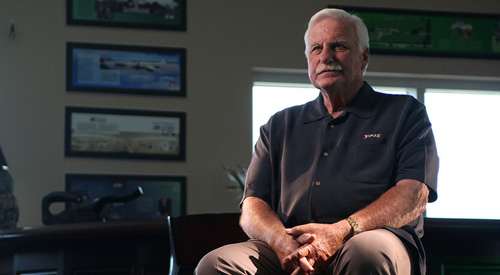
Howard Schnellenberger and the end of an era
Few college football observers are usually all that interested in the Florida Atlantic Owls, a middling team in the Sun Belt Conference, but they were the focus of much of the NCAA world last week.
Unlike many other schools that have made headlines lately, the sudden attention paid to Florida Atlantic wasn’t because of scandalous moves or rogue boosters. Instead, it was for all the right reasons: 77-year-old head coach Howard Schnellenberger announced he would retire at the end of the season, and the college football world lined up to pay tribute to one of their legends.
Any credible list of college football’s most famed coaches would certainly include Schnellenberger, a man who left major, lasting impacts on three schools as a head coach. Schnellenberger’s life in football went just beyond those moments, though, as he made impacts everywhere he went across leagues and eras (and not just in suspender advocacy). He was connected to many of the sport’s other well-known men, too.
Schnellenberger got his start in the college ranks as an All-American tight end at Kentucky and then transitioned into coaching there, coaching ends under Blanton Collier. After that, he headed to Alabama and served as Bear Bryant’s offensive coordinator for five years, winning three national championships in the process.
Schnellenberger then left for the NFL, first serving as George Allen’s tight ends coach with the St. Louis Rams before leaving for Miami to work as offensive coordinator for the legendaryDon Shula in 1970. He led the Dolphins of Larry Czonka, Jim Kiick and Mercury Morris to three famous seasons, including their perfect 1972 campaign that still hasn’t been equalled. Afterwards, he was hired as a head coach in Baltimore, but that didn’t work out so well; Schnellenberger’s Colts went 4-10 in his first season and were 0-3 in his second when he was fired. However, that firing may have been for the best, as after a brief return to Miami, he rejoined the college game, which would be a very different place today if he’d stayed in the professional ranks.
[php snippet=1]
In 1979, he became the head coach of the NCAA’s Miami Hurricanes. Miami was no powerhouse in those days and actually came close to dropping football shortly before Schnellenberger was hired, but that changed quickly. He only stayed there for a few years, but revolutionized the program with a “State of Miami” focus on recruiting local talent, a pro-style passing attack and the installation of a confident swagger that would come to define the Hurricanes. Out of nowhere, Miami rose from perennial doormats at the start of his tenure to the 1983 national championship, and gained a foundation that would lead them to decades of subsequent success.
After that 1983 season, Schnellenberger attempted to head back to the professional ranks as the head coach of a new Miami USFL team. That didn’t work, though, as the USFL’s shift to the fall prompted the team’s relocation to Orlando and dismissal of Schnellenberger in the process. He wasn’t out of work for long, though, heading back to Kentucky to take over the struggling Louisville program. Schnellenberger took the Cardinals from a struggling program to a powerhouse, and they made their first New Year’s Day bowl game appearance ever under him in 1991, thumping Alabama 34-7 in the Fiesta Bowl. Schnellenberger also played a crucial role in Louisville’s efforts to build an on-campus stadium. The project wasn’t completed until after he left, but that doesn’t diminish the importance of his service. That was recognized by the school, as they named it the Howard L. Schnellenberger Football Complex in honor of his contributions to the program.
Schnellenberger’s final act came on a lower-profile stage with Florida Atlantic (following an unsuccessful year with Oklahoma), but that doesn’t diminish what he accomplished there. He went far above and beyond the duties of your typical football coach, raising the money necessary to start the program from scratch and lobbying state politicians. On the field, he led the program through the 1-AA (now FCS) ranks and oversaw their promotion to the Sun Belt, and he wasn’t content to stop there, leading them to a conference title and a bowl game in 2007, just their third season at the top level. Schnellenberger also oversaw the fundraising necessary to build an on-campus stadium, which will open this year. Before he leaves this time, he’ll get to see the fruits of his labor.
Overall, Schnellenberger will be remembered as not just a legendary program-builder, but also as a relic of a different time. There aren’t too many people left who worked with the likes of Bryant and Shula, and it’s awfully tough to quickly build a program into a national powerhouse the way he did these days given the national recruiting climate and the strength of the top conferences. Spencer Hall made an excellent analogy upon Schnellenberger’s retirement, comparing him to famed Austrian prince Otto von Habsburg, another man who made notable impacts in diverse arenas over wildly different eras. In the end, that might be the best description of Schnellenberger; everywhere he went, he made his presence felt.
[php snippet=1]

